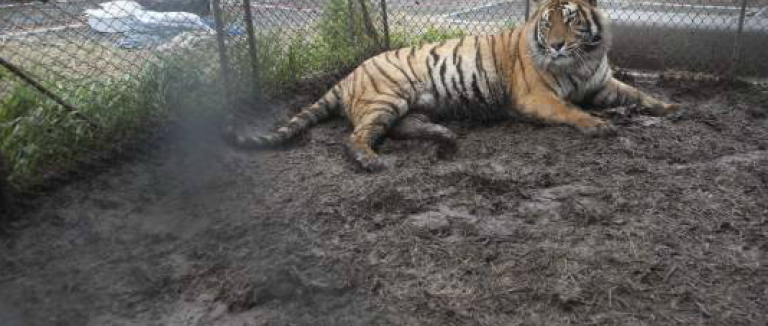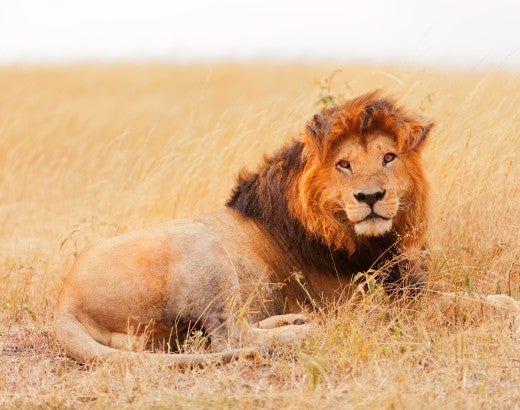Over the weekend, Americans were shocked by an incident at the Conservators Center in North Carolina, a privately run wild animal menagerie, where a 22-year-old intern who was cleaning an enclosure was attacked and killed by a lion. Law enforcement shot and killed the lion in order to retrieve the young woman’s body.
The incident is a tragic reminder of the dangers associated with the private ownership of exotic wild animals by individuals or organizations who are often not qualified to take care of them. Forty-six states now have laws against such ownership, with North Carolina being the glaring exception, in addition to Alabama, Nevada and Wisconsin.
The Conservators Center, which claims to rescue animals but also breeds them in captivity, has no credentials as a sanctuary. According to a CNN report, the center houses more than 20 species of exotic animals, including about 20 big cats (lions, leopards and tigers). However, it is not accredited by the Association of Zoos and Aquariums or the Global Federation of Animal Sanctuaries, the two organizations that are widely recognized as having serious standards. The center does have a U.S. Department of Agriculture license, which is completely insufficient as a guarantor of public safety and animal welfare, as has been proven time and again, because nearly 80 percent of dangerous big cat incidents occur at USDA licensed facilities.
Media reports said USDA inspectors found no Animal Welfare Act violations during its last two inspections at the Conservators Center, but they failed to mention that the federal law is weak and poorly enforced. Licensees can—and often do—keep animals in inhumane, unhealthy and unsafe conditions, and are yet not cited for violations of the AWA. USDA licenses are not species-specific and not all dangerous species are regulated. USDA licenses are automatically renewed every year, even when a licensee has had serious and/or repeated AWA violations. To make matters worse, there’s been a dramatic decline in AWA enforcement actions under the current administration.
Against this background, it becomes even more imperative for states and the federal government to engage in additional actions, including legislative remedies, to protect their citizens. Based on data compiled by the Humane Society of the United States, tigers have been responsible for half of the 377 dangerous incidents in 46 states and the District of Columbia involving big cats, with lions coming in second. People have also been killed by a cougar, a leopard, a jaguar and a liger (a cross between a tiger and a lion).
Big cats, like lions and tigers, are not pets -- they are powerful and dangerous wild animals. Since 1990, 24 people have been killed by captive big cats in the United States. Four of them were children, including a 10-year-old North Carolina boy who was mauled by his uncle’s 400-pound tiger as he shoveled snow near the tiger’s cage. The tiger reached under the fence and dragged the boy into the cage. In another North Carolina incident, a three-year-old boy was blinded when his father’s pet tiger bit and crushed his skull.
In other parts of the country, too, children have suffered traumatic and disfiguring injuries from captive big cats. Two youths were left paralyzed by tiger and lion attacks, a four-year-old had his arm torn off by his uncle’s tiger, and a teenager spent months in the hospital after being mauled by his father’s tiger. These incidents usually end with the animal being shot and killed.
The animals themselves suffer terribly in private hands. Big cats kept by unqualified people across the country have been found badly neglected and living in deplorable conditions ranging from junkyards to truck stops to tattoo parlors to empty, deteriorating concrete pools. There have been countless cruelty cases involving captive big cats. For example:
- A county sheriff in Kansas seized a tiger, two cougars and other animals held in flimsy, filthy cages on a rural property within sight of a children’s daycare. The tiger currently resides at one of the sanctuaries operated by our affiliate the Fund for Animals, the Cleveland Amory Black Beauty Ranch.
- A declawed tiger was found dead with five bullet wounds in a wooded area off a Texas interstate.
- Two lions and four tigers were abandoned in Ohio after the owner was evicted from a property, leaving taxpayers to foot the bill for their care until they were relocated to sanctuaries.
- A sick, malnourished and declawed cougar was abandoned at a roadside zoo in Nevada.
- Authorities found 58 dead tiger cubs in a freezer and about 30 dead tigers decomposing at a pseudo sanctuary in California. Thirty-nine abused tigers were seized and relocated to a sanctuary and the operator was convicted of child endangerment and animal cruelty.
The HSUS and the Humane Society Legislative Fund support a legislative solution at the federal level: the Big Cat Public Safety Act expected to be reintroduced in the 116th Congress. It will create a national framework for regulating the private possession of dangerous wild animals as well as prohibit public contact with certain species. The bill will address the thousands of animals being kept as pets or in grossly substandard conditions at unaccredited zoos, and end future ownership of big cats by unqualified individuals. It would also allow for a series of exemptions for individuals meeting specific requirements.
It was seven years ago when a suicidal man in Zanesville, Ohio, released 38 big cats and other dangerous animals from his backyard menagerie, creating a tragic situation for the animals who were hunted down and killed by authorities. Now, with the death of the North Carolina intern and, consequently, the animal who attacked her, we have yet another sad situation making the news. The HSUS takes an exacting view of situations that place people and wild animals in close proximity in captive settings, one that privileges human and animal safety above all else. North Carolina and the three other states without any laws regulating private ownership of exotic animals should act to protect their citizens before tragedy strikes again, and individuals who want to work with wild animals should scrutinize the practices of potential employers and seek opportunities at facilities that are accredited by AZA and GFAS.
P.S. In another incident over the weekend, a two-year-old girl had to be hospitalized after she fell into a rhino enclosure at the Brevard Zoo in Melbourne, Florida. Media reports said the incident happened during a hands-on exhibit, known as a Rhino Encounter, where guests are allowed to brush the rhinos and sometimes touch them by reaching between thick steel bars. The Florida Zoo is accredited by the AZA, but the HSUS does not support hands-on encounters where the public is allowed to interact directly with wild animals, because of the dangers those practices pose to humans and the stress it can cause the animals.



